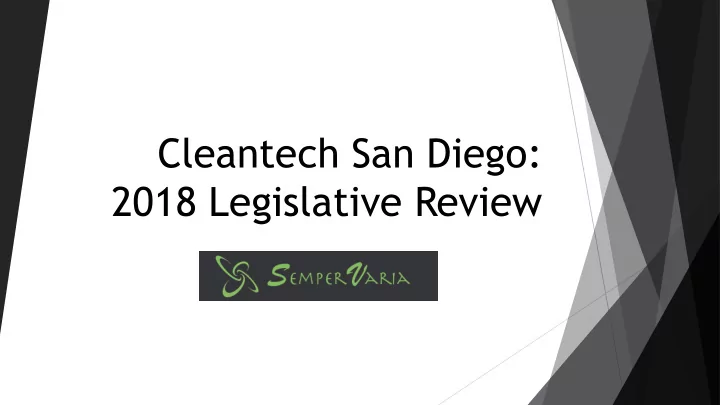

Cleantech San Diego: 2018 Legislative Review
AB 2127 & SB 1000 AB 2127 (Ting) Electric Vehicle Charging Infrastructure Assessment Codifies as a biennial requirement the Energy Commission statewide assessment of u the EV charging infrastructure needed to support at least 5 million ZEVs on the road and 40% GHG reduction from 1990 levels by 2030. Requires CEC to regularly seek data and input from CARB, CPUC, utilities, u transportation agencies, and private sector stakeholders relating to EV charging infrastructure. SB 1000 (Lara) Electric Vehicle Charging Infrastructure Deployment and Rates Requires the Energy Commission to evaluate if EV charging infrastructure is u disproportionately deployed by income level, population density and geographical area ; and to use ARFVTP funds and other mechanisms to more proportionately deploy chargers as needed. Requires the CPUC, in an existing proceeding , to explore submetering capabilities u for residential charging stations; technologies and rate models that reduce the effect of demand charges on EV and fleets; and adopting a specific tariff for heavy- duty EVs that encourages charging during periods of excess grid capacity. Prohibits local authorities to restrict access to charging stations that are publicly u accessible and publicly funded (in part or in full) in their permitting processes.
AB 2127 & SB 1000: Impacts The EV infrastructure planning and assessment requirement was originally spread u out between CEC and CARB by Executive Order AB 2127 codifies the report as part of the larger integrated energy policy report u containing an overview of major energy trends and issues facing the state including transportation forecasting. It specifically targets this section of the biennial report at trends and needs to meet 2030 goals. CEC stakeholder engagement processes are usually bi-monthly or quarterly u spread throughout the state. EV infrastructure companies and EV fleet managers should keep an eye out for the first event and make sure you are included in the stakeholders list for future engagements. While CEC events are SB 1000 supplements AB 2127 by including a specific type of assessment u (proportionality) for the report and provides an immediate funding vehicle to address major gaps as needed. This enables the deployment of funds much faster than any new program designed as a result of the larger biennial report. The requirements on the CPUC to look at new capabilities and EV rates in a u current proceeding could still show up in multiple dockets
SB 237 & SB 1136 SB 237 (Hertzberg) Raising the Cap on Direct Access for Commercial & Industrial Customers Requires the CPUC to issue an order by June 1, 2019 to increase the annual u maximum allowable total kWh limit for direct access by 4,000 GWh apportioned across IOU service territories. Requires the CPUC to provide the legislature with recommendations on the u adoption and implementation of a second direct transactions reopening schedule. SB 1136 (Hertzberg) Revising Objectives and Priorities for Resource Adequacy Requirements Directs the CPUC to adjust resource adequacy requirements for all load serving u entities (LSEs) through development and retention of generating, non-generating and hybrid capacity and advancing, where possible, state goals for clean energy and GHG emissions reductions to maintain system reliability and local area reliability and flexibility. Adds minimizing backstop procurement by CAISO as a specified purpose for LSEs u when meeting RA requirements.
SB 237 & SB 1136: Impacts SB 237 originally opened up Direct Access program to all nonresidential customers all u at once – both politically unpalatable and destabilizing to the current market. Initial 4,000 GWh is an incrementally small increase. Adding 4,000 GWh to the existing 24,000 GWh increases the share of statewide load u from about 13% today to about 15.5%. As of March 2018, the waitlist for DA was about 8,000 gigawatt-hours of load. Energy service providers (ESPs) are still subject to SB 100 and, similar to arguments u for CCAs, many corporate buyers who want to pursue direct access are using it to reach renewable energy targets faster than state mandates. Increases number and variety of LSEs in the CA energy market u u Could exacerbate current concerns regarding costs, oversight, and stability of the market u Creates an opportunity for energy developers to enter multi-offtaker contracts to improve project economics SB 1136 will likely shut down unnecessary natural gas-fired power plants faster u Addition of storage and other hybrid-generation technologies to RA requirements enhances u value of solar+ or wind+ storage developments and allows LSEs to contract with storage and local generation (”local area flexibility”) as opposed to natural gas plants u “Minimize backstop procurement” is a direct response to the recent CAISO/Calpine/PG&E RMR contracts approved in May.
Recommend
More recommend